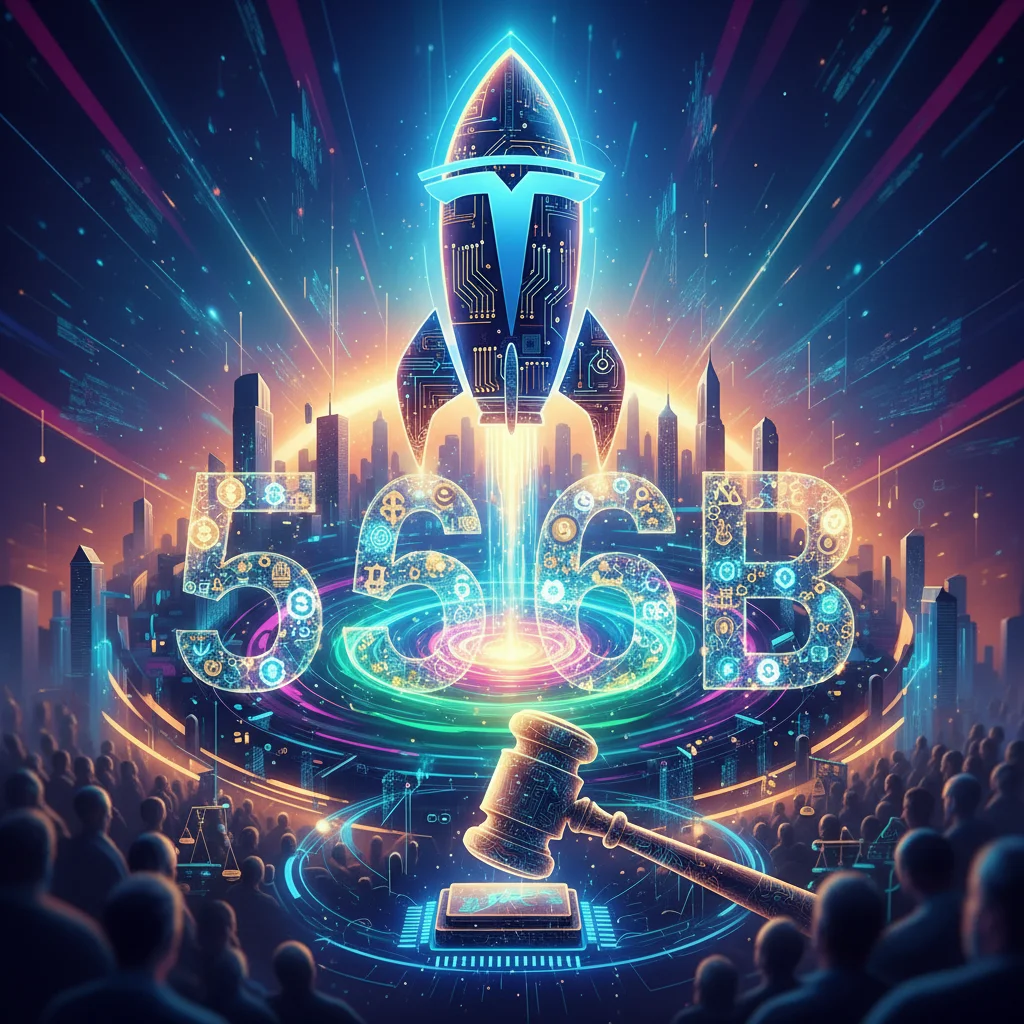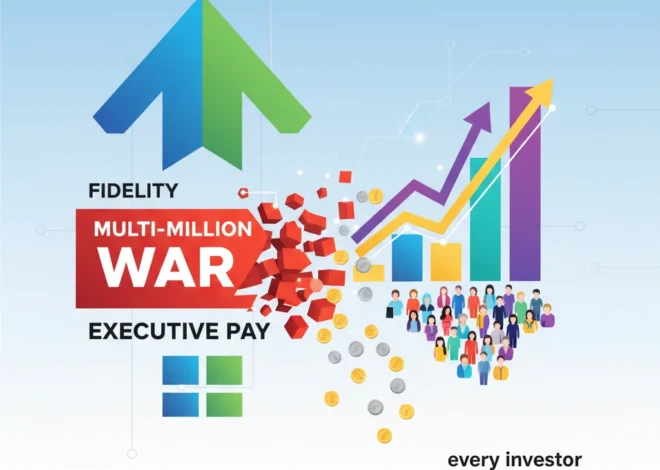
More Than a Paycheck: Why Tesla’s $56B Vote is a High-Stakes Bet on an AI-Powered Future
It’s a story that has everything: a visionary CEO, a mind-boggling sum of money, a courtroom drama, and a shareholder vote that could redefine corporate America. This week, Tesla shareholders voted to re-approve Elon Musk’s controversial 2018 pay package, a performance-based award once valued at up to $56 billion. While the headlines focus on the staggering dollar amount, the real story isn’t just about rewarding past achievements. This vote was a referendum on the future.
It was a decisive signal from investors that they are not just backing a car company; they are doubling down on a high-risk, high-reward transformation into a leader in artificial intelligence, robotics, and automation. The overwhelming approval, with preliminary results showing about 75% in favor, is less a paycheck and more a blank check for Musk to pursue a future where software and silicon are more important than steel and rubber.
For developers, entrepreneurs, and tech professionals, this decision is a landmark event. It raises critical questions about how we incentivize radical innovation, the role of founder-led companies, and the immense capital required to build the next generation of AI-driven technology. Let’s unpack the drama, the technology, and what this pivotal moment means for the future.
The Deal of the Century: A Look Inside the $56 Billion Plan
To understand the significance of the recent vote, we have to rewind to 2018. Back then, Tesla was a very different company. It was struggling with “production hell” for the Model 3, burning through cash, and its survival was far from guaranteed. To keep Musk intensely focused and incentivized, the board proposed a radical, all-or-nothing compensation plan. Musk would receive zero salary or cash bonuses. Instead, he would be granted options to buy massive tranches of Tesla stock, but only if he hit a series of incredibly ambitious milestones.
These weren’t soft targets. The plan laid out 12 tranches, each requiring Tesla to hit a specific market capitalization goal (starting at $100 billion and increasing in $50 billion increments) AND a corresponding operational milestone related to revenue or adjusted EBITDA. To unlock the full package, Musk had to grow Tesla’s market cap by an astounding $600 billion, from about $50 billion to $650 billion, and dramatically increase its financial performance.
At the time, Wall Street analysts called the targets ludicrous. Today, they look like a masterstroke of motivation. Here’s a simplified breakdown of the structure that turned a bold promise into a reality:
| Performance Requirement | Description | Outcome |
|---|---|---|
| Market Capitalization Growth | Achieve and sustain 12 market cap milestones, starting at $100B and ending at $650B. | Achieved. Tesla’s market cap soared, peaking at over $1.2 trillion in 2021. |
| Operational Milestones | Meet 16 specific revenue or adjusted EBITDA targets, proving the growth was based on real business performance. | Achieved. Tesla blew past the required financial metrics, becoming consistently profitable. |
| CEO Compensation | Elon Musk would receive no salary or cash bonuses. All compensation was tied to unlocking these stock option tranches. | Fully Vested. Musk met all conditions, vesting the full award of approximately 304 million stock options. |
The plan worked better than anyone imagined. Musk delivered, and Tesla became one of the most valuable companies in the world. But just as he was set to enjoy the fruits of his labor, the entire deal was thrown into jeopardy.
The AI Productivity Paradox: Are You Busier, or Actually Better?
The Delaware Courtroom Twist
In January 2024, the plan hit a legal brick wall. A Delaware Chancery Court judge, Kathaleen McCormick, voided the entire $56 billion package. In her ruling, she sided with a shareholder plaintiff who argued that the approval process in 2018 was “deeply flawed.” The judge concluded that Musk’s close ties with board members and his dominance over the company effectively meant he controlled the process, and that shareholders were not fully informed. The ruling described Musk as a “Superstar CEO” whose influence was so immense that the board’s negotiations were not truly at arm’s length.
The decision sent shockwaves through the corporate world and infuriated Musk, who promptly advised companies to never incorporate in Delaware. It also set the stage for this year’s dramatic shareholder meeting. Tesla’s board put the 2018 package up for a re-vote, essentially asking shareholders: “Knowing everything you know now, do you still approve?”
They also proposed moving Tesla’s state of incorporation from Delaware to Texas, a move widely seen as a direct response to the court ruling and a search for a more business-friendly legal environment. Shareholders approved that, too.
More Than Money: A Mandate for an AI-Powered Future
This is where the story pivots from a legal and financial drama to a referendum on the future of technology. The fervent support for Musk’s pay package, particularly from retail investors, isn’t just about rewarding him for the 10x stock growth. It’s an endorsement of his vision to evolve Tesla from an electric vehicle manufacturer into a diversified tech giant built on artificial intelligence.
Musk has been explicit that without a significant equity stake, he would be uncomfortable growing Tesla into an AI and robotics leader. He wants to ensure he has enough voting control to steer the company through the high-risk, long-term development cycles that AI requires. The re-approval of his pay package is the shareholders’ way of saying, “We trust your vision. Go build it.”
This vision rests on several key pillars, each a massive undertaking in software, machine learning, and hardware engineering:
- Full Self-Driving (FSD): This is the cornerstone of Tesla’s AI ambition. FSD is not just a driver-assist feature; it’s a quest to solve real-world autonomous navigation. It relies on collecting vast amounts of video data from its fleet, processed and trained on a massive supercomputing infrastructure. The evolution of FSD is a pure programming and AI challenge, and its success could unlock a recurring revenue model akin to a SaaS product for cars.
- Optimus Humanoid Robot: Unveiled at Tesla’s AI Day, Optimus represents a leap into general-purpose robotics. The goal is to create a robot that can perform dangerous, repetitive, or boring tasks, revolutionizing manufacturing and logistics. This requires breakthroughs in control systems, sensor fusion, and real-world interaction—all powered by sophisticated AI models.
- Dojo Supercomputer: To power these ambitions, Tesla is building its own custom supercomputer, Dojo. It’s an in-house cloud infrastructure designed specifically for the massive computational load of training neural networks for video data. This investment in custom silicon and architecture is a clear sign that Tesla sees its core competency as AI development, not just car manufacturing.
The Algorithm Police Are Here: Why the UK Is Auditing Big Tech’s AI
Let’s be clear: this vote is about more than just corporate governance. It’s a fascinating case study in the power of narrative and the cult of the visionary founder. The overwhelming “yes” from shareholders signals a belief that historic, game-changing innovation requires unconventional methods. The argument is that you can’t get a 100x outcome with a 1x compensation plan. In a world of startups trying to disrupt incumbents, this sets a powerful, if dangerous, precedent: go big, align the founder’s incentives completely with audacious goals, and the market might just reward you for it.
However, it also concentrates an immense amount of power and risk in one individual. What happens if the bet on full autonomy takes another decade? Or if the Optimus robot proves economically unviable? The vote effectively ties the company’s destiny to one person’s vision for an AI-driven future. It minimizes the checks and balances that traditional governance provides, creating an existential “key person” risk. For now, investors are comfortable with that risk. They believe Musk’s vision for artificial intelligence is the only path forward, but it’s a high-wire act with no safety net.
The Road Ahead: Legal Hurdles and the New Tesla
While Musk and the board are celebrating this victory, the fight isn’t over. The shareholder vote doesn’t automatically reverse the Delaware court’s ruling. Instead, it serves as a powerful new piece of evidence for Tesla’s legal team. They will use this ratification to argue in an appeal that the will of the shareholders is clear and should be respected. The outcome of that appeal remains uncertain, but the vote undoubtedly strengthens Tesla’s position.
The move to Texas is also significant. It signals a shift away from Delaware’s well-established but, in Musk’s view, overly activist judiciary. This could have long-term implications for corporate law in the United States as other companies watch to see how Tesla fares under Texas law.
For the tech industry, the implications are profound. This saga reinforces the idea that in the modern economy, value is increasingly tied to intellectual property, software, and data-driven services. Tesla’s valuation isn’t just about the cars it sells today; it’s a bet on the potential of a future fleet of autonomous robotaxis, a workforce of humanoid robots, and the licensing of its AI technology. This requires robust platforms, impenetrable cybersecurity, and a culture of relentless innovation.
The Spyware on Your Cap Table: When Big Law and Big Money Back Controversial Tech
A New Blueprint for Innovation?
The re-approval of Elon Musk’s pay package is a landmark moment. It’s a testament to his unparalleled ability to deliver on seemingly impossible goals and to inspire immense loyalty from his investor base. It challenges the traditional playbook of corporate compensation and governance, suggesting that for truly transformative companies, perhaps the old rules no longer apply.
This vote was a multi-billion-dollar bet that Tesla’s most valuable products are not yet on the market. They are still being coded in its labs, trained on its Dojo supercomputer, and designed for a future dominated by artificial intelligence and automation. The shareholders have spoken, and their message is clear: they are funding a revolution, not just a car company. Whether this becomes the new model for incentivizing radical innovation or a cautionary tale of corporate overreach is a chapter that is still being written.
